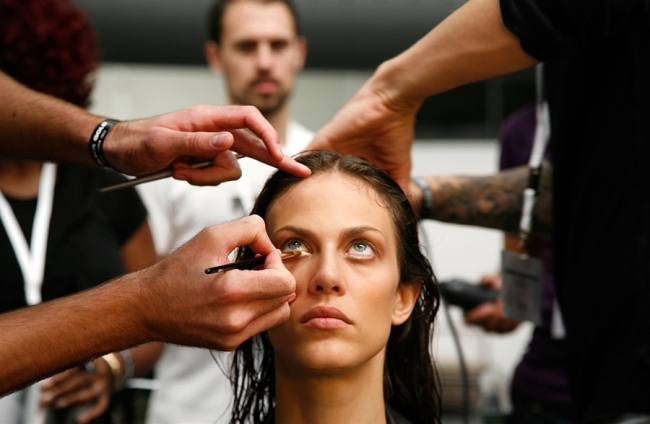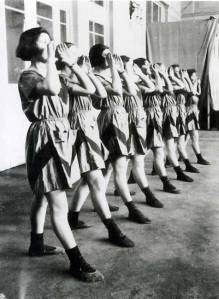Here’s an excerpt from my latest article, “Designing Women: Feminist Methodologies in American Fashion,” as published in the latest issue of WSQ: Fashion.
Visit Project MUSE to read the full article from Women’s Studies Quarterly, Volume 41, Numbers 1-2, Spring/Summer 2013.
__
In 1940, Elizabeth Hawes, a leading voice in American fashion and owner of one of the most exclusive couture businesses in New York, abandoned her career in fashion to take on the “war against fascism.” After working for several months as a critic for the leftist tabloid PM, she took a job as a machine operator at Wright Aeronautical, a New Jersey wartime plant, and published a memoir about her experiences entitled Why Women Cry, or Wenches with Wrenches (1943). At the heart of the book is a quest to explain “why women cry,” a problem she attributes to the crisis in domestic labor created by women’s entrance into wage work. She writes, “The world has been told, to the vomiting point, that a revolution is now in progress. Men: this revolution is likely to be brewing right in your own kitchen. For we . . . have all been notified that the day of the Common Man is coming up. Don’t think the Common Woman is just sitting around preparing to spend the whole of that day in the kitchen” (xi).
If the war had created certain economic opportunities for women, it had also sharpened gender inequities, Hawes argued, as the dual responsibilities of productive labor and social reproduction fell onto women’s laps amid the wartime crisis. She writes, “I am terrified we may not start soon enough to avert the Hitlerian routine of Children-Kitchen-Church for the new generation of the Common American Woman and do away with economic slavery to their husbands”(xi-xii). In response, Hawes proposes a revolutionary vision for the feminist reorganization of society, envisioning a world with employer-provided child care, self-cleaning homes, affordable public housing and health care, community restaurants, programs to promote women’s reproductive health, nondiscrimination in the workplace, dress reform, socialized beauty parlors and exercise facilities (so that everyone might have access to the “body beautiful”), and initiatives to encourage women to vote (Hawes 1943). Hawes imagined the achievement of this radical utopia through a cross-class alliance of “professionals in health and education and religious and welfare and housing; of Club-women and les Riches-Bitches and She-Wolves and thousands and thousands of just plain mothers, Womenworkers and Forgotten Females; we [would] all go ahead together to see that no child lacked what he needed” (xii).
Just how did Elizabeth Hawes, a household name in American fashion, go from couturier to trade unionist and radical feminist in a few short years? Some crucial answers lie in the social consciousness and feminist methodologies shared by a new generation of American designers like Hawes, who emerged in the turbulent political and economic climate of the Great Depression. Hawes was among a growing movement of women in fashion—designers, retail executives, fashion critics, and industry personalities—who collectively defined new approaches to fashion, rooted in women’s physicality and the promise of mass production. Under the framework of “Americanizing fashion,” these women challenged traditional business models in fashion and the mystique of Parisian haute couture. More than a patriotic appeal, the idea of American style provided an intellectual framework for women to engage critically with the fashion industry and the construction of femininity through mass culture. This essay reconstructs the political underpinnings of American fashion, pointing to 1) a new emphasis on sculptural design methodologies; 2) Hawes’s landmark critique, Fashion Is Spinach (1938), which attacked both French exclusivity and the empty rhetoric of material democracy by the American apparel industry; and 3) the conceptual ties between interwar American fashions and a longer tradition of “material feminism,” specifically dress reform (Hayden 1982).
…
Visit Project MUSE to read the full article from Women’s Studies Quarterly, Volume 41, Numbers 1-2, Spring/Summer 2013.



